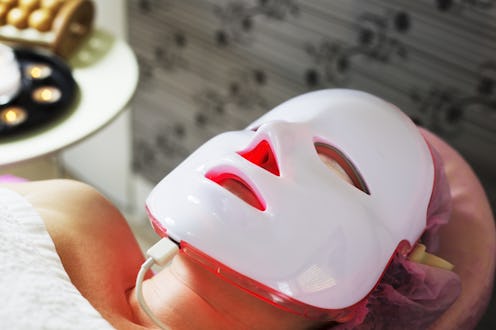Style
The Upsides & Downsides Of Investing In An LED Face Mask

A growing skincare trend is to take a treatment that was once solely available in professional clinics and bring it to the masses. Nowhere is this more true than with LED light therapy. The Hannibal Lecter-esque devices are everywhere, but there's a big question looming over them: do at-home LED face masks actually work? Or are you better off saving up for an appointment with a pro?
How LED masks work
To understand the value of LED masks, you need to understand how they work. It's simple: photobiomodulation. OK, so that doesn't sound very simple. Basically, photobiomodulation is a word describing the way light affects biological material like skin, per the New York Times. Although sun rays can detrimentally impact skin, other kinds of light have a positive influence. LED lights are one of them.
Take a quick scroll through your Instagram feed, and you'll notice several different colours emitting from such face masks. These shades (or wavelengths, as they're otherwise known) aren't there to create a pretty picture, but to help the skin in various ways.
"The masks send energy into the cells to stimulate natural cellular responses," says Colorescience skin specialist Patricia Boland. Blue light, for example, targets bacteria that causes acne, per Vogue. Red goes deeper to reduce inflammation and build collagen that diminishes fine lines and wrinkles, green can help with pigmentation, and yellow is used for wound healing, Stylist notes.
Is there any research to back up claims about LED masks?
When used together, red and blue lights — the most commonly used wavelengths — have been found to significantly improve both non-inflammatory and inflammatory acne over the course of a month. The study, published in the British Journal of Dermatology, used an at-home device.
However, there has been little independent research into at-home LED masks, states beauty and lifestyle site Hello Giggles, aside from studies conducted by brands themselves. "I would want to see further studies on long-term use, particularly excessive use," dermatologist Dr. David Lortscher told the publication.
In the summer of 2019, there was concern over the safety of such devices when a hugely popular one, Neutrogena's Light Therapy Acne Mask, was recalled in the U.S. as well as Australia over potential eye damage.
"Reports of visual effects ... are rare, generally mild, and transient," Neutrogena said in a statement. But Australia's Department of Health noted that people with certain eye disorders could experience irreversible retinal damage. Protecting your eyes with blackout goggles or thick pads is therefore advisable, reports Vogue.
The pros and cons of at-home LED masks
There are some distinct benefits to at-home LED therapy. "They will help to a small degree," notes Dr. Ross Perry, medical director of Cosmedics UK. Boland believes "the ease and results of [these masks] make [them] a worthy investment as your skin will look like you’ve put in months of effort." Plus, there's the cheaper price — although some can cost several hundred pounds.
Don't expect a miracle, though, say experts. "The strength of the mask is weaker than a professional treatment," Boland explains, "because the home face masks can be used daily whereas a professional treatment is used once a month." So it will take more time to notice results.
To make the most of an at-home device, stick to a consistent regime. Use every day on top of a clean face, advises Boland. You will also need to use the mask for around 20 to 30 minutes, Dr. Perry adds, and it "won't be the relaxing experience you might envisage."
Other steps to take include ensuring you're using the correct wavelength for your skin concern, following manufacturer's instructions, and trialling for at least four to six weeks before examining the results.
When to book a professional LED mask appointment
Seeking professional assistance will cost you more, of course. Prices vary, but a low-cost single session can be around £50. Visiting a clinic, however, is more likely to give you the results you're aiming for. Not only are their LED devices much stronger, but staff know exactly which wavelength combination to use on your skin and how to use them safely.
A good treatment plan may involve both professional and at-home LED therapy. At-home masks are "great for upkeep after you’ve completed a full session and for upkeep if you have to space out your sessions," dermatologist Dr. Dendy Engelman told Byrdie.
But the consensus among experts seems to be: opt for the more expensive course of treatment. "If you are looking for immediate and consistent effects, then a professional option is better suited," Boland finishes.